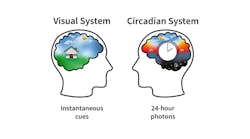This article was originally published on ElectroIQ.
+++
Last year has been an outstanding one for LED-related equipment sales. However, this former bright sky overclouds for capital expenditures in 2012, and many market analysts project around 18% decay for this years’ equipment sales. But to keep things straight, this number is mainly related to MOCVD sales, making up for about 50% of the LED equipment pie in one fab. In fact, downstream processes -- including lithography, bonding, testing or packaging -- are expected to further increase in capex for 2012.
Changing requirements
Traditionally, the most important factor for LED manufacturers has been tool cost. This was especially true for any downstream process after MOCVD growth. Today, these requirements are changing. More complex chip layouts for higher lumen output and increased LED efficiencies demand more sophisticated processes and equipments. Having said that, the focus of LED makers is shifted to more traditional values of equipment requirements, such as higher automation, enhanced yield and increased throughput.
It’s all about efficiency
Based on the Department of Energy LED manufacturing roadmap, costs are still a factor of 5-8 too high to trigger mass adoption of solid state lighting technology and efficiently compete with alternative technologies. This cost target directly rolls back to LED manufacturers and hence the equipment supplier, demanding for more efficient manufacturing technologies. Therefore, three general decision factors have been established, namely capital efficiency, footprint efficiency and cost of ownership. Capital efficiency basically tells the number of processed wafers per unit time for any capital dollar spent. Footprint efficiency gives the wafer output per unit time for any square-metre of fab space. Efficient use of precious fab space is very closely linked to how profitable a LED fab can be operated. Combining these factors lead to cost of ownership, being traditionally used in semiconductor industry rather than the LED industry.
Applying the above metrics to any process step illustrates their importance. As an example, optical lithography is the general applied patterning technique for LED manufacturing. With three to seven lithography layers – depending on application and LED complexity – any advantage in these metrics is multiplied several times. Thus, mask aligners can considerably leverage manufacturing cost. The newly developed EVG620HBL has been optimized according to these metrics. The system delivers industry-leading throughput and more than 20% increased capital efficiency as well as footprint efficiency.
Upcoming technical challenges
Another hot topic is patterned sapphire substrates (PSS), which enable higher light extraction and a reduced defect density. Looking into the future, feature sizes of PSS will be further minimized into the sub-micrometer range, leading to so-called nanometer PSS (NPSS). These NPSS substrates show considerable advantages, including further reduced defect density and increased extraction efficiency compared to micron-sized PSS. In this way, the overall LED efficiency is improved. Even a comparatively small increase in overall LED efficiency can considerably reduce the required chip area for a certain lumen output. Hence, LED efficiency is an important lever for cost reduction. Furthermore, when using NPSS, cost reduction is enabled by shortened sapphire etching and shortened growth time in the MOCVD, due to reduced feature size of NPSS substrates. On the other hand, manufacturing cost of NPSS is the same as standard PSS. With nano imprint lithography (NIL) and PHABLE, EVG has two different, cost-efficient technologies implemented in its portfolio.
In conclusion, with MOCVD market saturation, the focus of the LED industry is shifted to downstream processes. Increasing process yield and cost efficiency will be a central aspect for future equipment decisions of LED manufacturers. Advanced manufacturing technologies, to increase overall LED efficiency, are generating added value to current process flows.




